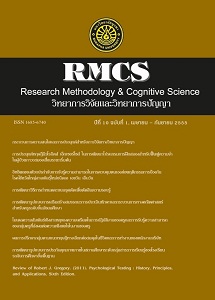อิทธิพลของตัวแปรกำกับการรับรู้ความสามารถในการควบคุมตนเองต่อพฤติกรรมการป้องกันโรคไข้หวัดใหญ่สายพันธุ์ใหม่ชนิดเอ เอชวัน เอ็นวัน
Main Article Content
Abstract
Influence of Perceived Control as Mediator for Influenza A (H1N1) Preventive Behavior
Sita Pleejan1, Poonpong Suksawang2 and Supim Sripunvoraskul2
1Banphaeng Hospital, Nakhonphanom Province
2College of Research Methodology and Cognitive Science Burapha University, Thailand
The objectives of this research were to develop and validate a causal relationship model of perceived control as mediator for preventive behavior measures against influenza A (H1N1), and to check the consistency of the developed model with empirical data. The model consisted of five latent variables: attitude toward behavior, subjective norms, perceived behavior control, behavioral intention, and preventive behavior. The sample consisted of 450 high school students in the 2012 academic year in Nakhon Phanom Province under Basic Education Commission, all selected by multistage random sampling. Data were collected by questionnaires. Descriptive statistics were generated using SPSS; causal mode analysis involved the use of LISREL.
Results indicated that the causal model of perceived control as mediator for preventive behavior on influenza A (H1N1) was consistent with empirical data: Chi-square test of goodness of fit = 74.18, p =0.06, df =57, GFI =0.98, AGFI =0.94, CFI = 1.00, SRMR =0.02, RMSEA = 0.03 and R2 = 0.42. The variables in the model accounted for 42% of the variance in preventive behavior on influenza A (H1N1). The highest direct effect for preventive behavior was the interaction of perceived behavior control and behavioral intention.

